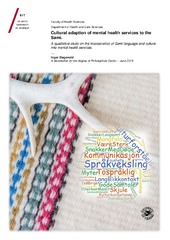Cultural adaption of mental health services to the Sami. A qualitative study on the incorporation of Sami language and culture into mental health services
Permanent lenke
https://hdl.handle.net/10037/16468Dato
2019-10-18Type
Doctoral thesisDoktorgradsavhandling
Forfatter
Dagsvold, IngerSammendrag
The Sami people in Norway have a statutory right to receive equitable health services, adapted in accordance with Sami language and culture. However, limited research is available regarding the impact and of Sami culture and language within mental health services.
Aim - The overall aim of the study was to explore, identify and describe the significance of culture and language in mental health services as experienced by clinicians and Sami patients, to enhance the understanding of the cultural and linguistic adaptation of the services to the Sami.
Methods - The data was co-constructed in individual interviews with clinicians and Sami patients in mental health clinics in northern Norway. The data were analysed thematically.
Results - The study demonstrated that Sami patients’ language choice is influenced by a complexity of social and cultural factors. Bilingual Sami patients have different preferences for what they can talk about, in which language, in what way and with whom. However, the result must not be confused with saying that Sami-speaking patients do not need Sami-speaking therapy. Essentialist descriptions of Sami culture were several, but ways to incorporate cultural and linguistic aspects into mental health services were limited. Organisational support for language appropriate services was limited. Culturally adapted clinical interventions were lacking. Incorporation of culture and language was random, provided by the individual clinician within the structural frames and with the knowledge available.
Concluding remarks - The study indicates that the incorporation of language and culture into mental health care is a complex process involving strategies at three levels; institutional systems and structures, health professionals’ cultural assumptions and analytical competence, and cultural assessment of interventions within mental health treatment. Stereotypical portrayals of Sami culture narrow the understanding of Sami identity, delimit the identification of Sami-speakers and simplifies possible impacts of culture within health care. Therefore, the question is not what culture “is”, but how culture unfolds in human encounters.
Har del(er)
Paper 1: Dagsvold, I., Møllersen, S. & Stordahl, V. (2015). What can we talk about, in which language, in what way and with whom? Sami patients’ experiences of language choice and cultural norms in mental health treatment. International Journal of Circumpolar Health, 74(1), 26952. Also available in Munin at https://hdl.handle.net/10037/8726.
Paper 2: Dagsvold, I., Møllersen, S. & Stordahl, V. (2016). “You never know who are Sami or speak Sami.” Clinicians’ experiences with language-appropriate care to Sami-speaking patients in outpatient mental health clinics in Northern Norway. International Journal of Circumpolar Health, 75(1), 32588. Also available in Munin at https://hdl.handle.net/10037/10126.
Paper 3: Dagsvold, I., Møllersen, S., Blix, B.H. Clinicians’ assumptions about Sami culture and their experiences with providing mental health services to indigenous Sami patients in Norway. (Accepted manuscript).
Forlag
UiT The Arctic University of NorwayUiT Norges arktiske universitet
Metadata
Vis full innførselSamlinger
- Doktorgradsavhandlinger (Helsefak) [770]
- ISM skriftserie [161]
Følgende lisensfil er knyttet til denne innførselen:


 English
English norsk
norsk
